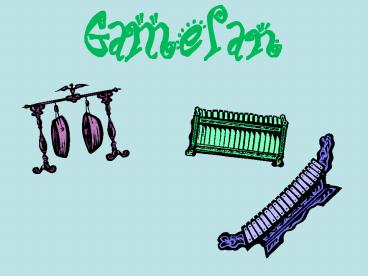Gamelan - PowerPoint PPT Presentation
1 / 23
Title:
Gamelan
Description:
... percussion instruments: gongs, metallophones, xylophones, drums, cymbals, flutes. ... They're cone-shaped with two drum skins, one larger and one smaller. ... – PowerPoint PPT presentation
Number of Views:3578
Avg rating:3.0/5.0
Title: Gamelan
1
Gamelan
2
What is gamelan?
- Gamelan is a traditional Indonesian instrumental
ensemble made up of mainly percussion instruments
gongs, metallophones, xylophones, drums,
cymbals, flutes.
3
Where does gamelan come from?
- Gamelan comes from Indonesia
- There are two main styles Balinese (from Bali)
and - Javenese (from Java)
4
(No Transcript)
5
What does it sound like?
Listen to the following examples of gamelan music.
Some western composers have been heavily
influenced by gamelan music. Its influences can
be especially seen in minimalism which shares
many of the same features repetition, cyclic
rhythms, loops etc
6
The Slendro Scale
C D E G A
The five-note Gamelan scale is called the
Slendro. Gamelan notes dont exactly match
Western scales but the slendro is roughly
equivalent to the notes of the major pentatonic
scale on C C,D,E,G,A
7
The Pelog Scale
C D E A B C D
The seven-note gamelan scale is called the
Pelog. To get an idea of what the pelog scale
sounds like, play the notes E,F,G,A,B,C,D on a
keyboard. Most sets of gamelan are tuned either
to the slendro or to the pelog scale. Others are
tuned to both these are called double gamelan.
8
Instruments with keys
- The keys of an instrument can be bronze, iron,
wood or bamboo. They are arranged in a
xylophone-like manner, always horizontally. The
player faces the long side of the instrument.
9
- The Gambang is a xylophone with wooden bars
10
- The Gender has narrow keys
- made of bronze.
- Below the keys thee are bamboo
- pipes which resonate with the
- sound, making
- it sound
- bigger
- and richer.
11
Gongs
- Gongs are in bronze or iron. They always have a
central knob (peñcu).
12
The Bonang family are instruments with two rows
of gongs resting on cords across a wooden frame.
13
- The biggest hanging gong is called the Gong
Ageng. It usually plays on the last beat of the
rhythmic cycle.
14
- The Kempul is a smaller hanging gong.
15
- The Kenong and Ketuk are gongs which rest
horizontally on cords stretched across a wooden
box.
16
- The Suling is a bamboo wind instrument, like a
flute but you blow through the end, not over the
side - The Rebab is a two stringed fiddle
17
The bigger drum is the Kendang Gending and the
smaller one is called the Ketipung. Theyre
cone-shaped with two drum skins, one larger and
one smaller. Theyre played resting sideways, so
the drummer can play one skin with each hand.
18
(No Transcript)
19
(No Transcript)
20
(No Transcript)
21
(No Transcript)
22
(No Transcript)
23
In groups compose a Balinese-style piece that
consists of the following layers1 an 8 or 16
note core melody which uses the notes of the
slendro scale, and moves in even crotchets.2
an alto/tenor part which only plays notes 1,3,5
and 7 (and 9,11,13,15)3 a bass part which only
plays notes 1 and 5 (and 9 and 13)4 - a
two-part interlocking melody of 8 beats































